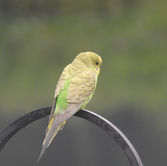Budgerigar (Parakeet)
Common Name: Budgerigar (Parakeet).
Scientific Name: Melopsittacus Undulatus.
What to look for? BI thought I saw a parakeet! I did! Budgerigars are small parrots – or parakeets to us. They are small – sparrow-sized. Budgerigars have a yellow forehead, a yellow and black striped head with purple or blue markings on the cheeks. They have a pointed bill whose tip of the upper mandible extends over the lower mandible. And they a yellow throat. They have pointed wings and tails with distinct plumage patterns. Their uppertail coverts are bright green and extend to a blue-green tail. Their body is a bright green.
Where can they be found at Carillon Stonegate Pond? The sighting of a Budgerigar around Carillon Stonegate Pond is rare. If they do show up, they may be foraging below your bird feeder. Early summer is best time of year if they decide to visit.
How big are they? Budgerigars average approximately seven (7) inches in length. And their wingspan is approximately fourteen (14) inches. They weigh in at just over one (1) ounce.
What are their flight patterns? During forward flight, Budgerigars engages in of two flight styles: flap-gliding and flap-bounding. During hovering, it uses a continuous flapping style.
How else do they behave? The activity of the Budgerigar begins in the morning with preening, singing, and movement within trees. After sunrise, the birds fly to the foraging area and feed throughout the day. During midday or in extremely hot weather, they shelter under shade. At the end of the day, they congregate by calling loudly and return to their roosting site just after sunset where they will remain at rest until the next morning. Budgerigars aggregate into large flocks and are strongly social. There does not seem to be any hierarchy in groups based upon the relatively few battles among individuals.
What’s for dinner? Budgerigars are ground-feeders, preferring to take the seeds of native grasses and crop plants. They first dehull the seed and then swallow it whole or broken. Budgerigars are very disciplined in their drinking habits, drinking about 5% of their body weight daily. The bulk of drinking and feeding activity is in the morning.
Where do they take up residence? Australia - not Aurora! Budgerigar is native to and found across much of Australia. This species has also been introduced to many areas around the world, including the U.S., and many other countries. They reside in semi-arid and sub-humid habitats.
When and where do they breed and nest? Budgerigars make their nest in pre-existing cavities that are available in fence posts, logs, and Eucalyptus trees. They breed throughout the year so long as seed (food) is available. Budgerigars are socially monogamous. Females lay four (4) to eight (8) eggs which hatch after about eighteen (18) days. Young birds fledge about a month after hatching.
Where do they migrate? Budgerigars seasonally migrate to warmer climates during the winter in order to have a continuing food source.
What is their conservation status? There is low concern. Budgerigars are generally abundant throughout their native range (Australia). Populations are estimated at over 5 million and growing.
Do they make any interesting sounds? The song of the Budgerigar is a chattering warble, interspersed with screeching notes. Here is a link to the sounds of the Budgerigar.
Interesting Facts About the Budgerigar:
-
The lifespan of the Budgerigar can exceed fifteen (15) years.
-
There are 115 known species of parakeet – of which the Budgerigar, or common parakeet, is one.
-
The typical parakeet is covered with around 3,000 feathers.
-
A parakeet can rotate it is head 180°!
-
Since its introduction into captivity, the Budgerigar (or 'budgie') has been bred into a variety of color forms, including pure white, blue, yellow, mauve, olive and grey.
-
The greatest threat to the Budgerigar is nature itself: droughts and heat waves can lead to die off.
For more information on the Budgerigar and sources of information used in this blog (these are the sources that I am using to learn as I blog), please visit Audubon Society, University of Michigan Animal Diversity Web, A-Z Animals, and Texas A&M AgriLife Research.
The Carillon at Stonegate community is very fortunate to have a variety of wetland, forest and prairie environments conducive to a variety of birds and other wildlife, plants and insects. Our community and the Kane County Forest Preserve do an exceptional job in maintaining this natural environment – both for the benefit of the birds and wildlife and for our residents to enjoy.
Take a hike and see what you can find – and identify!











